Communication Performance Assessment for Advanced Metering Infrastructure
Abstract
:1. Introduction
- Using some communication quality measurements easily acquired from a smart meter to design a CPI.
- Through the calculated CPIs, the communication performance and stability of AMI can be effectively assessed and supervised.
- The proposed CPI and communication performance assessment would be supportive of the future deployment and operation of AMI.
2. Design of an Effective CPI
3. Communication Performance Assessment for AMI
4. Simulation and Experimental Results
4.1. A Simple Six-Meter Case
4.2. Field Measurements and Communmication Performance Assessment
5. Conclusions
Author Contributions
Acknowledgments
Conflicts of Interest
References
- Samad, T.; Annaswamy, A.M. Controls for smart grids: Architectures and applications. Proc. IEEE 2017, 105, 2244–2261. [Google Scholar] [CrossRef]
- Masera, M.; Bompard, F.E.; Profumo, F.; Hadjsaid, N. Smart (electricity) grids for smart cities: Assessing roles and societal impacts. Proc. IEEE 2018, 106, 613–625. [Google Scholar] [CrossRef]
- Collier, S.E. Ten steps to a smarter grid. IEEE Ind. Appl. Mag. 2010, 16, 62–68. [Google Scholar] [CrossRef]
- Liu, W.-H.E. Analytics and information integration for smart grid applications. In Proceedings of the IEEE Power and Energy Society General Meeting, Detroit, MI, USA, 24–29 July 2010; pp. 1–3. [Google Scholar]
- Farhangi, H. The path of the smart grid. IEEE Power Energy Mag. 2010, 8, 18–28. [Google Scholar] [CrossRef]
- “Global Smart Meter Market Expected to See Huge Rollout”. GlobalData Energy. Available online: https://www.power-technology.com/comment/global-smart-meter-market-expected-see-huge-rollout/ (accessed on 17 September 2018).
- “Advanced Metering Infrastructure Market Research Report—Global Forecast to 2023”. Half-Cooked Research Reports. Available online: https://www.marketresearchfuture.com/reports/advanced-metering-infrastructure-market-5185 (accessed on 20 November 2018).
- Strother, N.; Lockhart, B. Smart Electric Meters, Advanced Metering Infrastructure, and Meter Communications: Global Market Analysis and Forecasts; Navigant Research: Boulder, CO, USA, 2014. [Google Scholar]
- Uribe-Pérez, N.; Hernández, L.; de la Vega, D.; Angulo, I. State of the Art and Trends Review of Smart Metering in Electricity Grids. Appl. Sci. 2016, 6, 68. [Google Scholar] [CrossRef]
- Ghosal, A.; Conti, M. Key Management Systems for Smart Grid Advanced Metering Infrastructure: A Survey. arXiv 2018, arXiv:1806.00121v1. [Google Scholar]
- Sial, A.; Singh, A.; Mahanti, A.; Gong, M. Heuristics-Based Detection of Abnormal Energy Consumption. In Proceedings of the SmartGIFT 2018: Smart Grid and Innovative Frontiers in Telecommunications, Auckland, New Zealand, 23–24 April 2018; pp. 21–31. [Google Scholar]
- Yan, Y.; Qian, Y.; Sharif, H.; Tipper, H. A Survey on Smart Grid Communication Infrastructures: Motivations, Requirements and Challenges. IEEE Commun. Surv. Tutor. 2013, 15, 5–20. [Google Scholar] [CrossRef] [Green Version]
- Matanza, J.; Alexandres, S.; Rodriguez-Morcillo, C. Advanced metering infrastructure performance using European low-voltage power line communication networks. IET Commun. 2014, 8, 1041–1047. [Google Scholar] [CrossRef]
- Chi, H.R.; Tsang, K.F.; Chui, K.T.; Chung, S.H.; Ling, B.W.K.; Lai, L.L. Interference-mitigated ZigBee-based advanced metering Infrastructure. IEEE Trans. Ind. Inform. 2016, 12, 672–684. [Google Scholar] [CrossRef]
- Artale, G.; Cataliotti, A.; Cosentino, V.; Cara, D.; Fiorelli, R.; Guaiana, S.; Panzavecchia, N.; Tinè, G. A new PLC-based smart metering architecture for medium/low voltage grids: Feasibility and experimental characterization. Measurement 2018, 129, 479–488. [Google Scholar] [CrossRef]
- Aalamifar, F.; Lampe, L. Optimized data acquisition point placement for an advanced metering infrastructure based on power line communication technology. IEEE Access 2018, 6, 45347–45358. [Google Scholar] [CrossRef]
- Ancillotti, E.; Bruno, R.; Conti, M. The role of the RPL routing protocol for smart grid communications. IEEE Commun. Mag. 2013, 51, 75–83. [Google Scholar] [CrossRef]
- Yang, Z.; Ping, S.; Sun, H.; Aghvami, A.H. CRB-RPL: A receiver-based routing protocol for communications in cognitive radio enabled smart grid. IEEE Trans. Veh. Technol. 2017, 66, 5985–5994. [Google Scholar] [CrossRef]
- Malandra, F.; Sansò, B. A Markov-modulated end-to-end delay analysis of large-scale RF mesh networks with time-slotted ALOHA and FHSS for smart grid applications. IEEE Trans. Wirel. Commun. 2018, 17, 7116–7127. [Google Scholar] [CrossRef]
- Gentile, C.; Griffith, D.; Souryal, M. Wireless network deployment in the smart grid: Design and evaluation issues. IEEE Netw. 2012, 26, 48–53. [Google Scholar] [CrossRef]
- Jiang, J.; Qian, Y. Distributed communication architecture for smart grid applications. IEEE Commun. Mag. 2016, 54, 60–67. [Google Scholar] [CrossRef]
- Ramírez, D.F.; Céspedes, S.; Becerra, C.; Lazo, C. Performance evaluation of future AMI applications in Smart Grid Neighborhood Area Networks. In Proceedings of the IEEE Colombian Conference on Communication and Computing (IEEE COLCOM 2015), Popayán, Colombia, 13–15 May 2015; pp. 1–6. [Google Scholar]
- Malandra, F.; Sanso, B. PeRF-Mesh: A performance analysis tool for large scale RF-mesh-based smart meter networks with FHSS. In Proceedings of the 2015 IEEE International Conference on Smart Grid Communications (SmartGridComm), Miami, FL, USA, 2–5 November 2015; pp. 792–797. [Google Scholar]
- Vondrouš, O.; Macejko, P.; Hégr, T.; Kocur, Z. Testing methodology for performance evaluation of communication systems for smart grid. In Proceedings of the 2016 2nd International Conference on Intelligent Green Building and Smart Grid (IGBSG), Prague, Czech Republic, 27–29 June 2016; pp. 1–6. [Google Scholar]
- Argoneto, P.; Renna, P. Capacity sharing in a network of enterprises using the Gale–Shapley model. Int. J. Adv. Manuf. Technol. 2013, 69, 1907–1916. [Google Scholar] [CrossRef]
- Liu, Y.K.; Zhang, L.; Tao, F.; Wang, L. Resource service sharing in cloud manufacturing based on the Gale–Shapley algorithm: Advantages and challenge. Int. J. Comput. Integr. Manuf. 2017, 30, 420–432. [Google Scholar]
- Zadeh, L.A. The concept of a linguistic variable and its applications to approximate reasoning-I. Inf. Sci. 1975, 8, 199–249. [Google Scholar] [CrossRef]
- Zadeh, L.A. The concept of a linguistic variable and its applications to approximate reasoning-II. Inf. Sci. 1975, 8, 301–357. [Google Scholar] [CrossRef]
- Teng, J.H.; Liao, S.H.; Wen, C.K. Design of a fully decentralized controlled electric vehicle charger for mitigating charging impact on power grids. IEEE Trans. Ind. Appl. 2017, 52, 1497–1505. [Google Scholar] [CrossRef]
- Hannan, M.A.; Ghani, Z.A.; Mohamed, A.; Uddin, M.N. Real-time testing of a fuzzy-logic-controller-based grid-connected photovoltaic inverter system. IEEE Trans. Ind. Appl. 2015, 51, 4775–4784. [Google Scholar] [CrossRef]
- Chang, E.J.; Hsin, H.K.; Lin, S.Y.; Wu, A.Y. Path-congestion-aware adaptive routing with a contention prediction scheme for network-on-chip systems. IEEE Trans. Comput.-Aided Des. Integ. Circuits Syst. 2014, 33, 113–126. [Google Scholar] [CrossRef]
- Wu, D.; Ci, S.; Wang, H.H.; Katsaggelos, A.K. Application-centric routing for video streaming over multi-hop wireless networks. IEEE Trans. Circuits Syst. Video Technol. 2010, 20, 1721–1734. [Google Scholar] [CrossRef]
- Ma, K.; Liu, X.; Yang, J.; Liu, Z.; Yuan, Y. Optimal Power Allocation for a Relaying-Based Cognitive Radio Network in a Smart Grid. Energies 2017, 10, 909. [Google Scholar] [CrossRef]
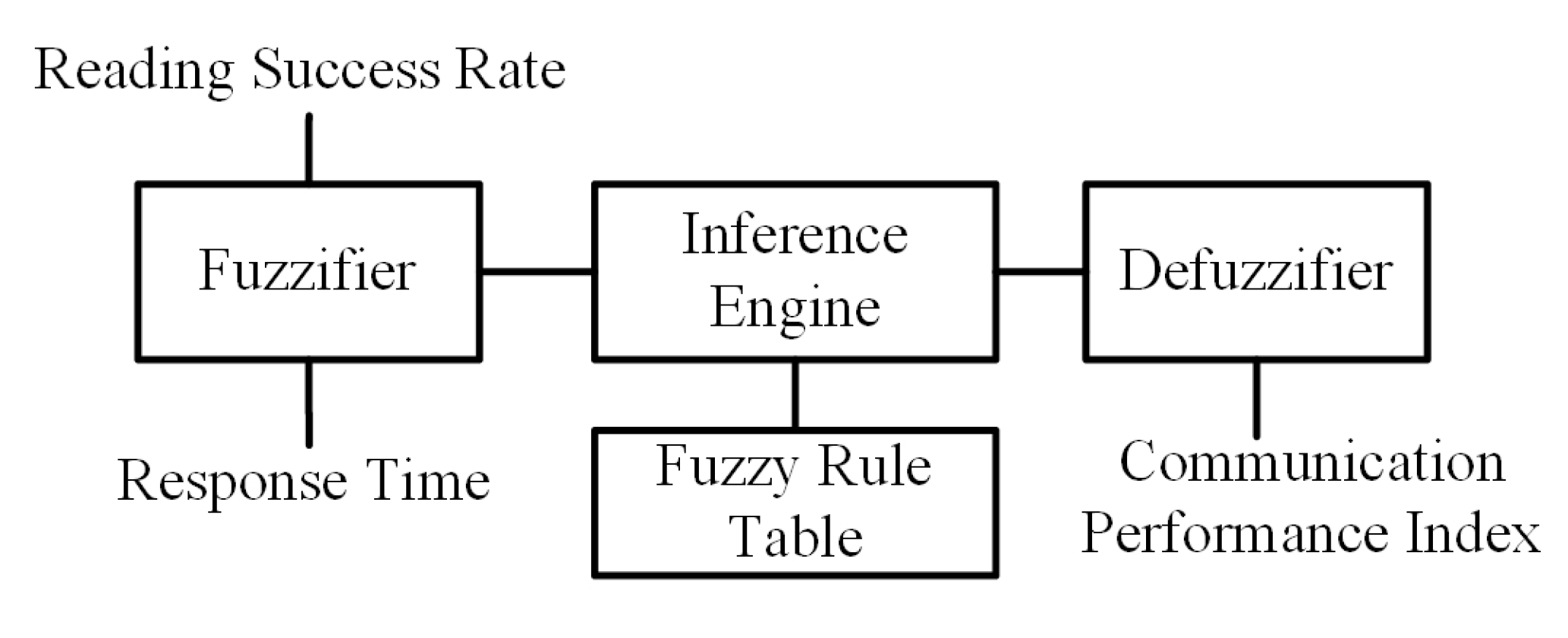



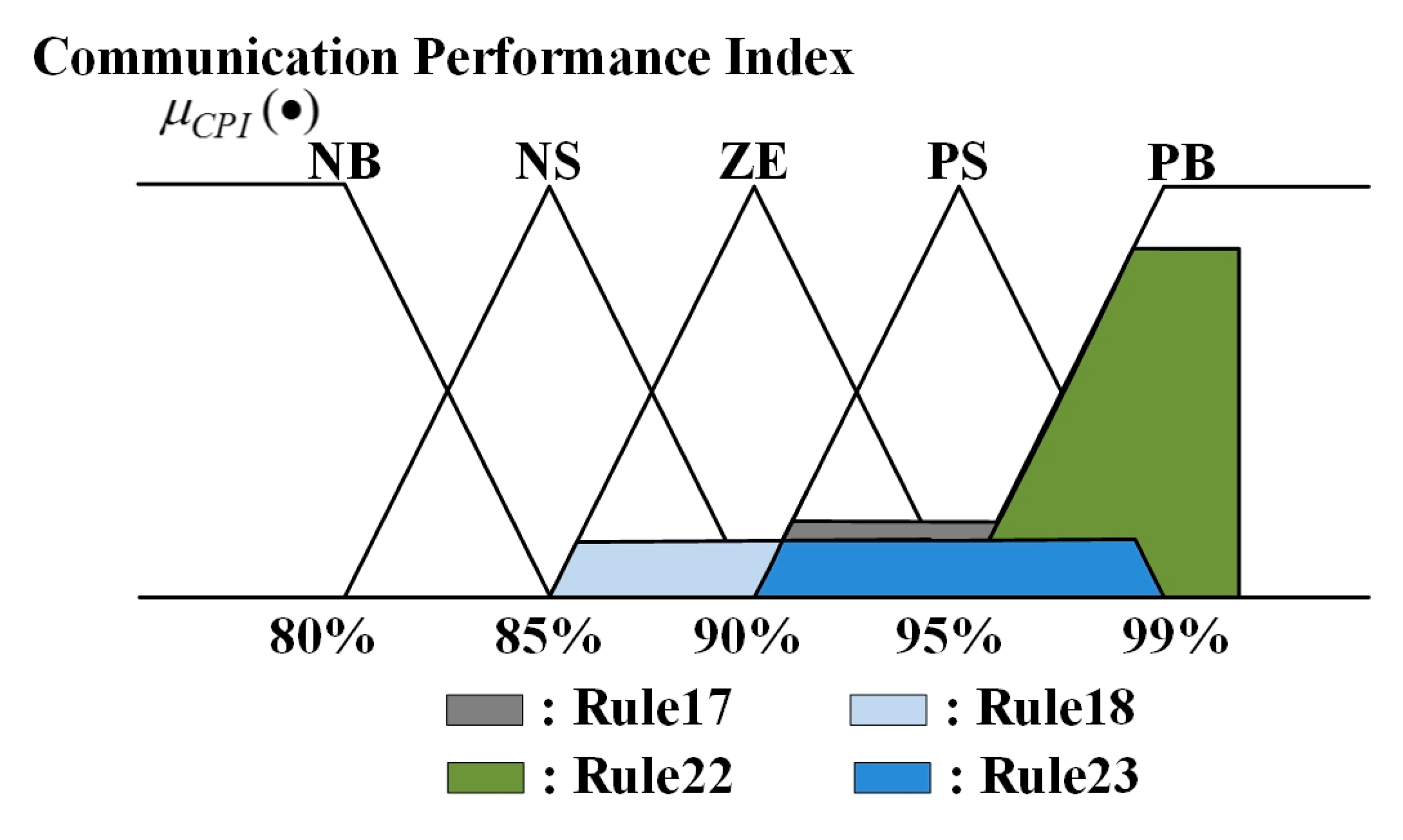

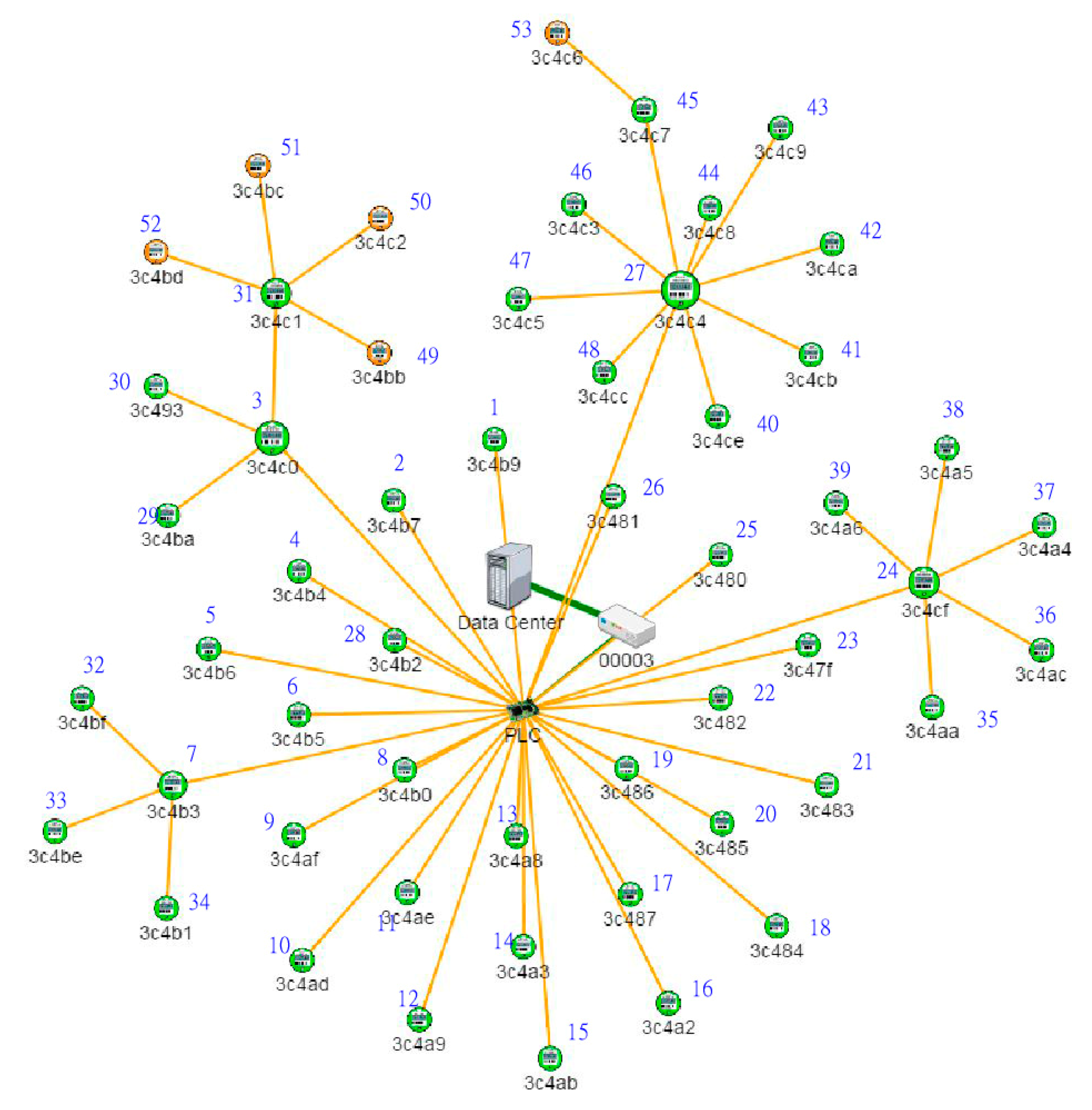
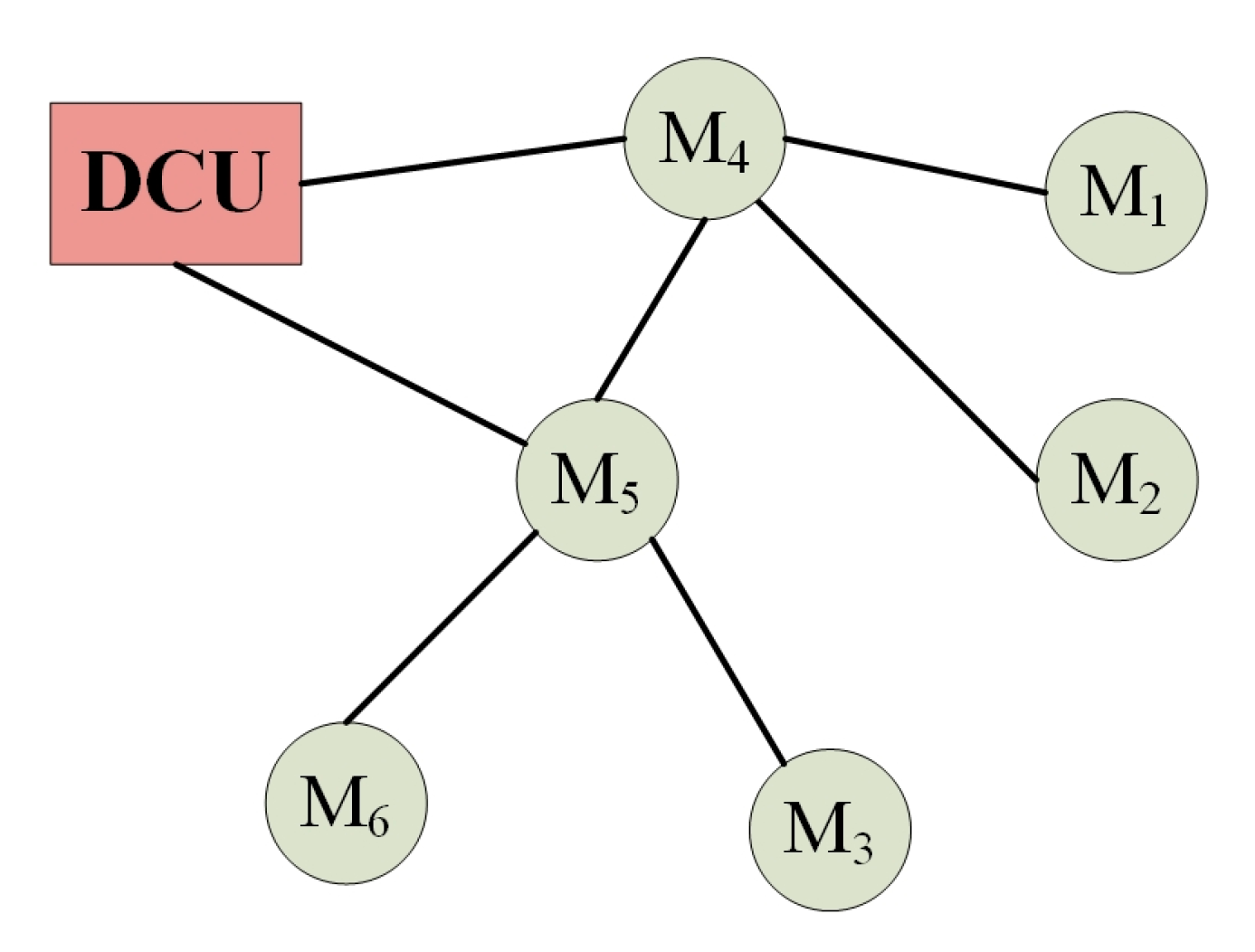
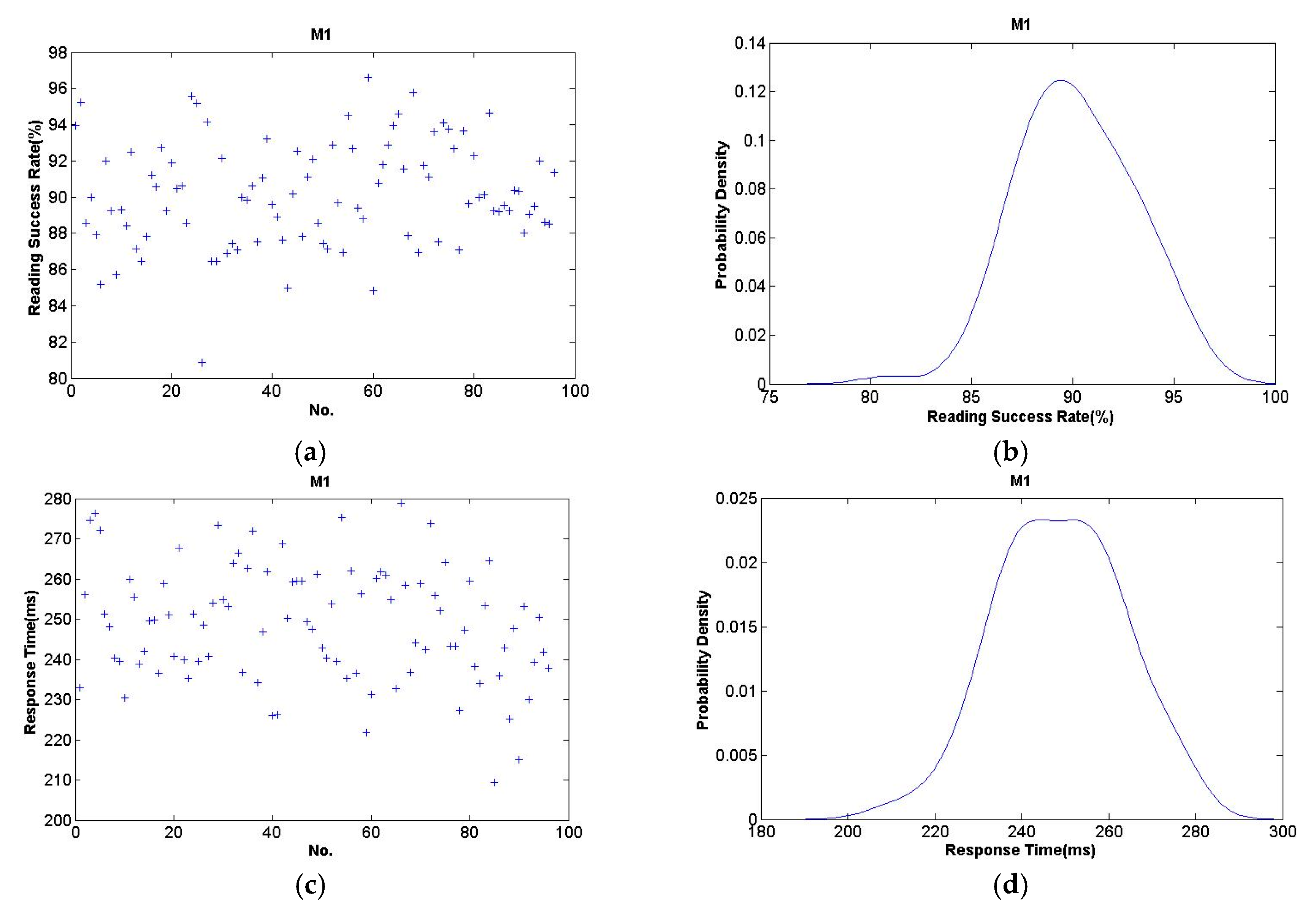
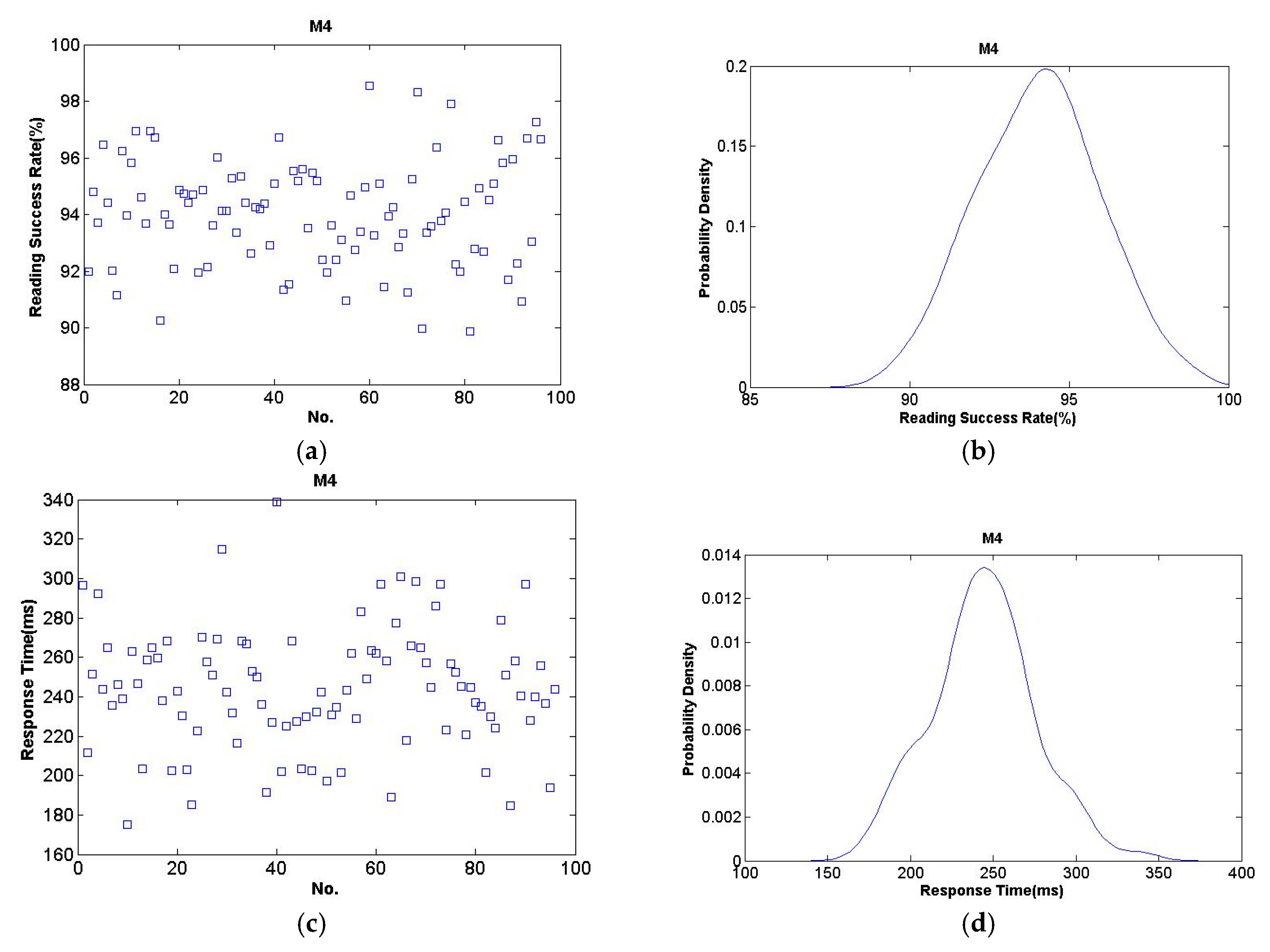

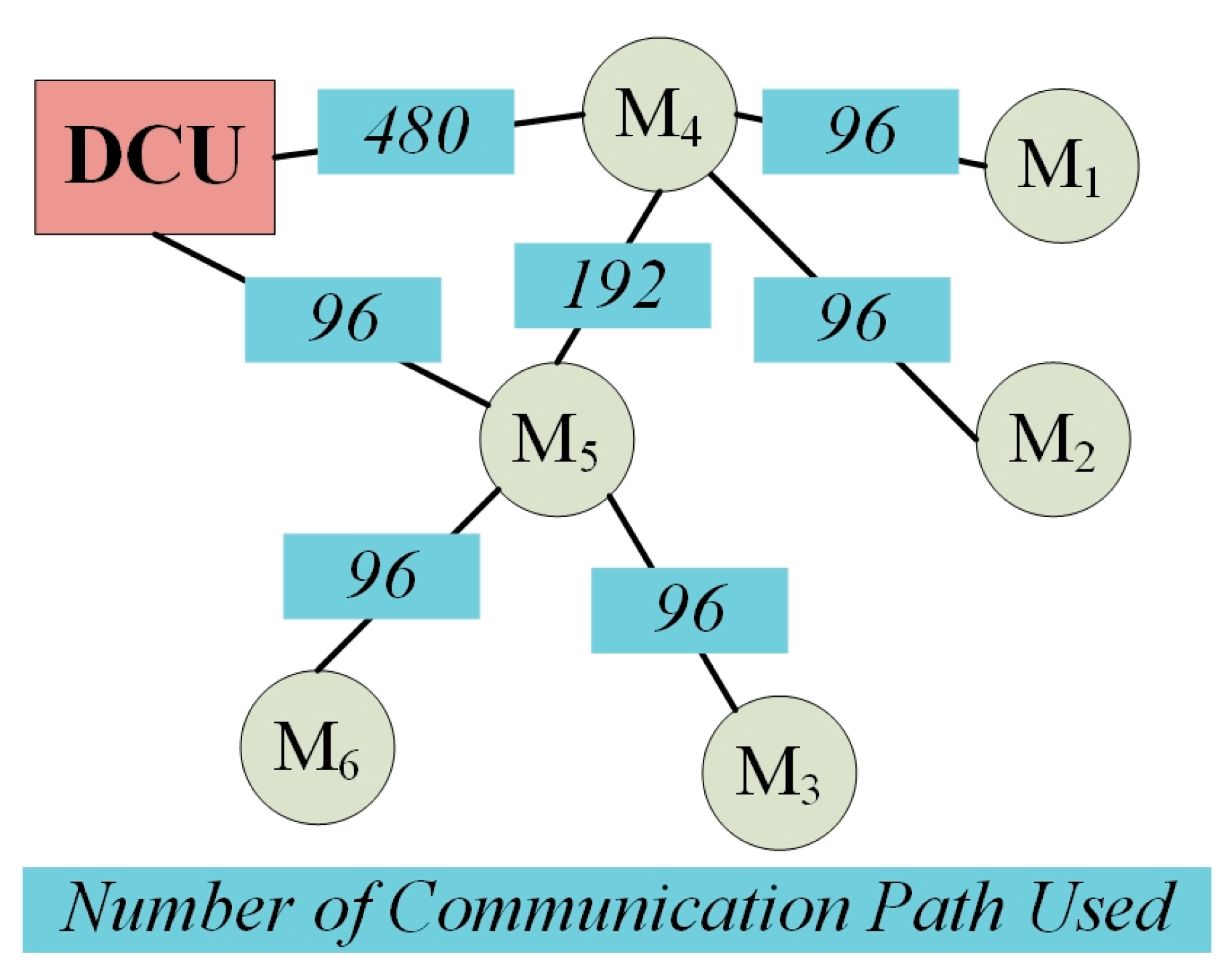


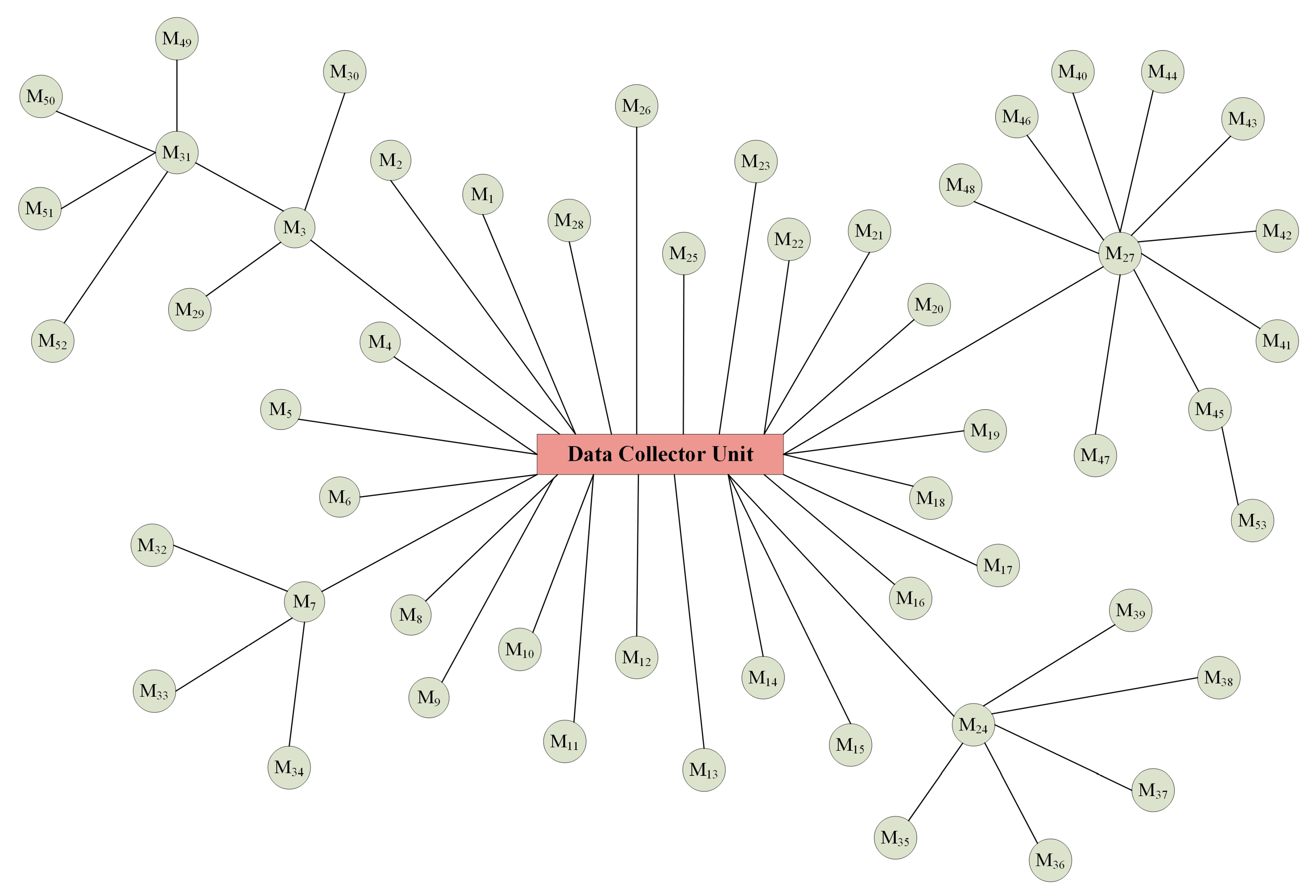
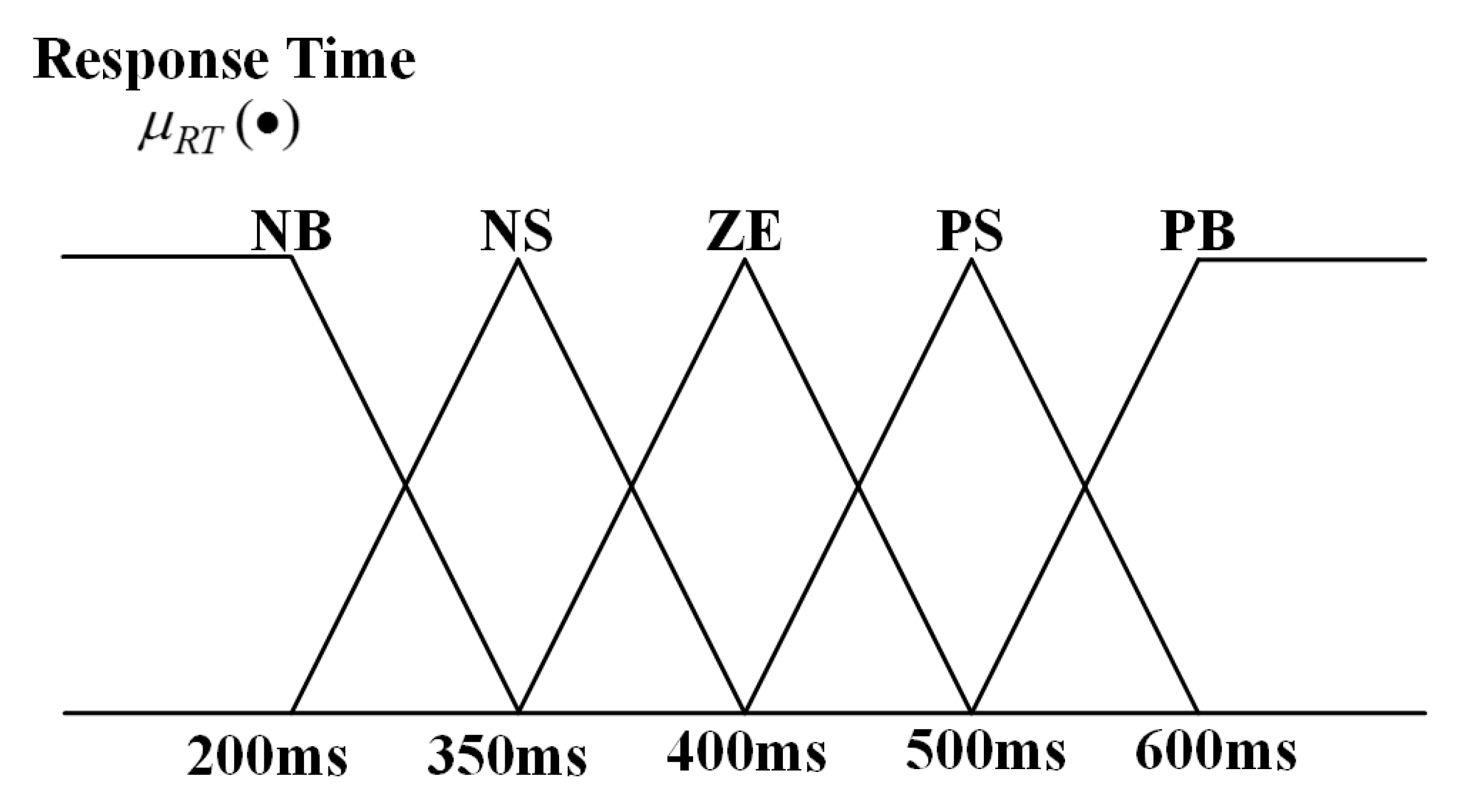
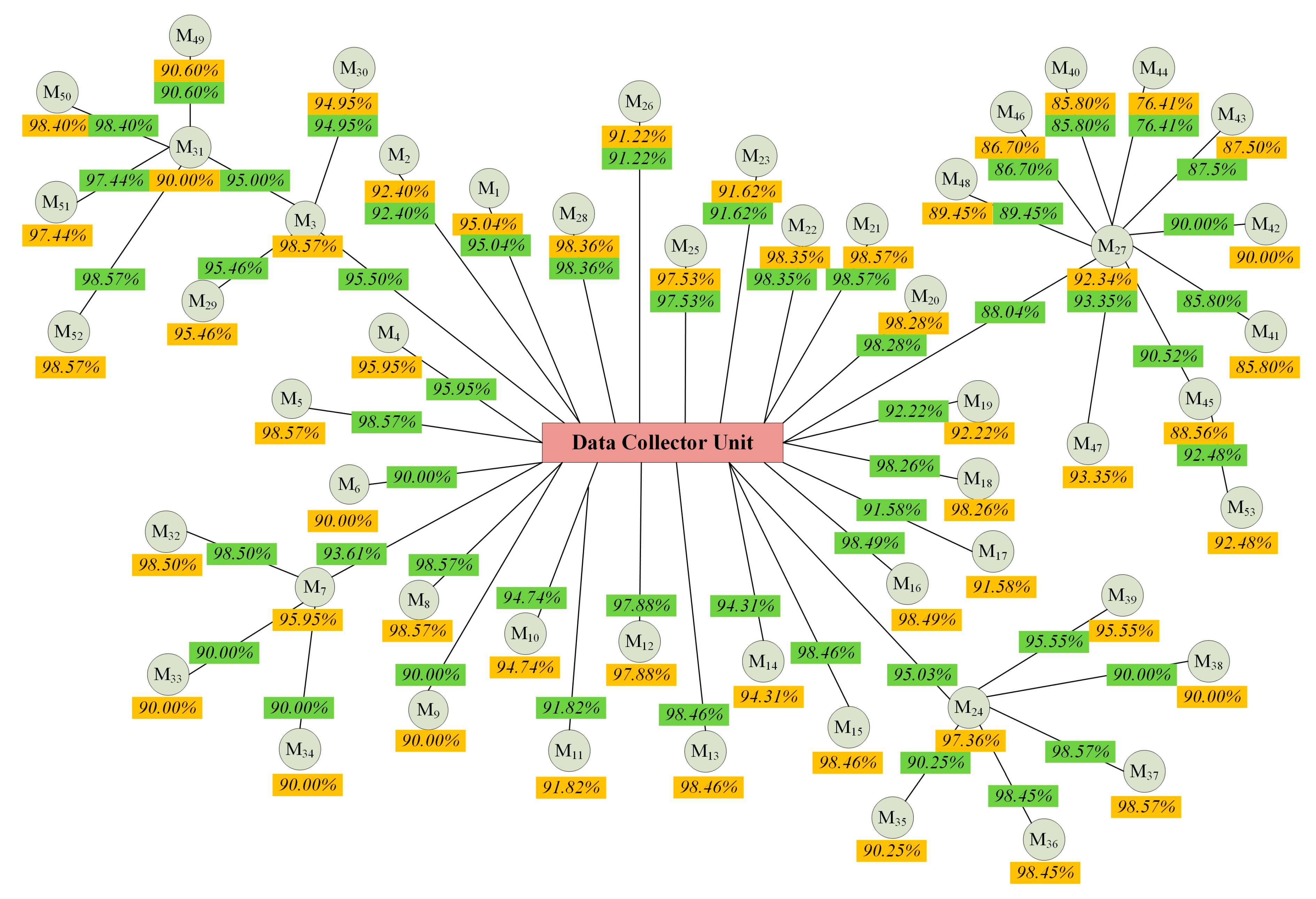
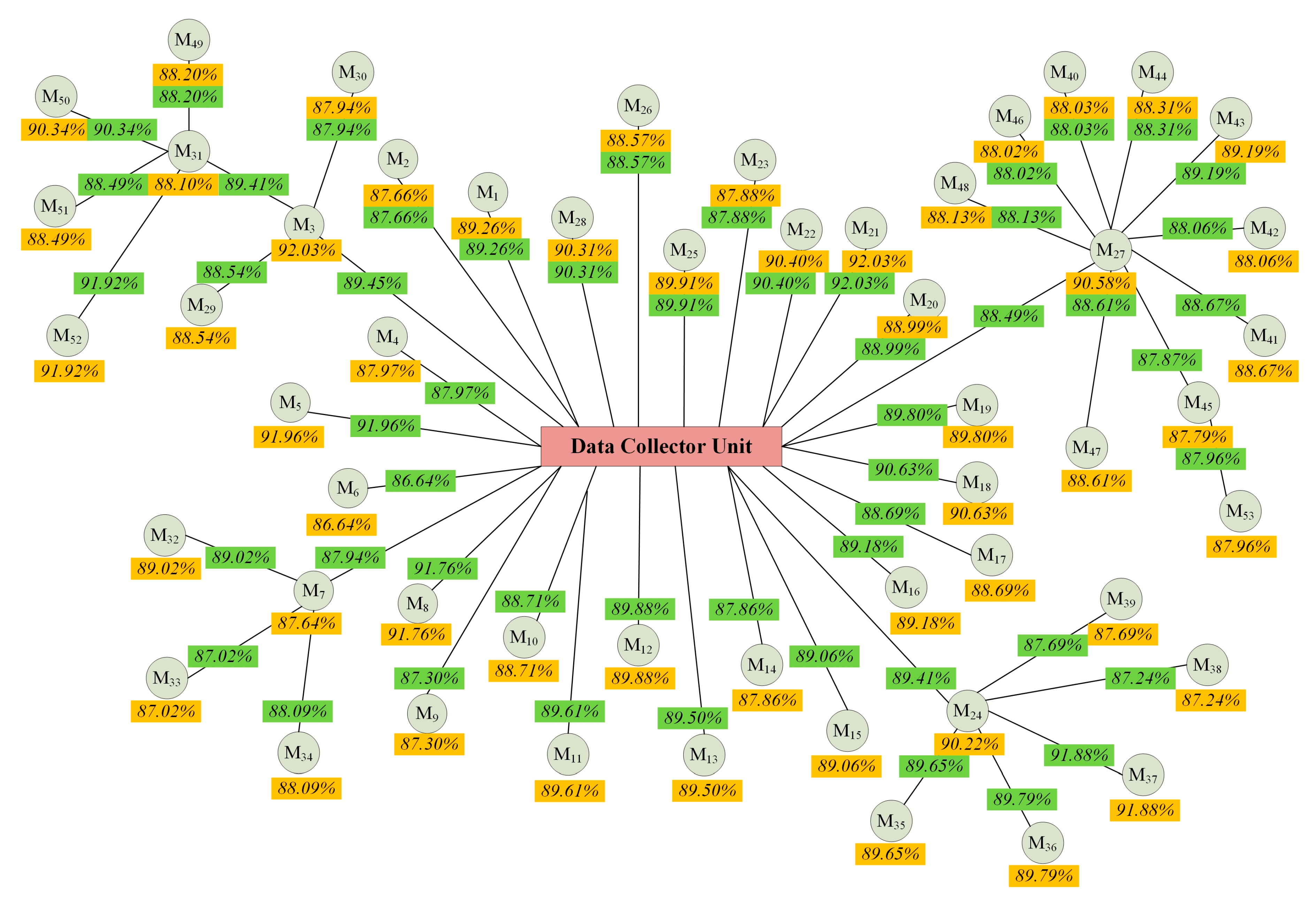
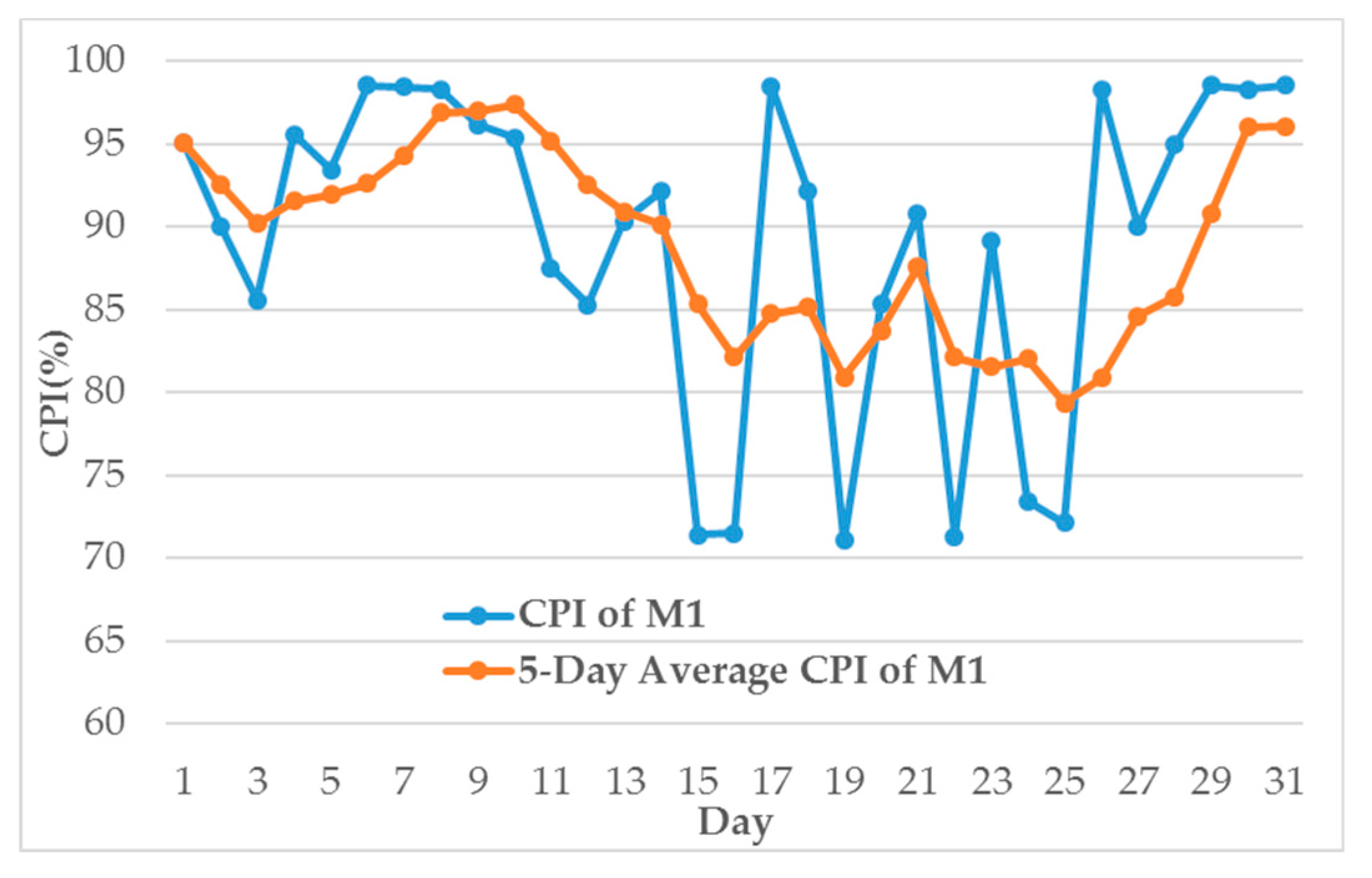
| RSR * | RT * | ||||
|---|---|---|---|---|---|
| NB | NS | ZE | PS | PB | |
| NB | Rule1 NB | Rule2 NB | Rule3 NB | Rule4 NB | Rule5 NB |
| NS | Rule6 NS | Rule7 NS | Rule8 NB | Rule9 NB | Rule10 NB |
| ZE | Rule11 ZE | Rule12 ZE | Rule13 NS | Rule14 NS | Rule15 NB |
| PS | Rule16 PS | Rule17 PS | Rule18 ZE | Rule19 NS | Rule20 NS |
| PB | Rule21 PB | Rule22 PB | Rule23 PS | Rule24 ZE | Rule25 ZE |
| RSR | RT | ||||
|---|---|---|---|---|---|
| NB | NS | ZE | PS | PB | |
| NB | Rule1 NB | Rule2 NB | Rule3 NB | Rule4 NB | Rule5 NB |
| NS | Rule6 NS | Rule7 NS | Rule8 NB | Rule9 NB | Rule10 NB |
| ZE | Rule11 ZE | Rule12 ZE | Rule13 NS | Rule14 NS | Rule15 NB |
| PS | Rule16 PS | Rule17 PS = min(0.25,0.80) | Rule18 ZE = min(0.25,0.20) | Rule19 NS | Rule20 NS |
| PB | Rule21 PB | Rule22 PB = min(0.85,0.80) | Rule23 PS = min(0.85,0.20) | Rule24 ZE | Rule25 ZE |
| Meter | Communication Path |
|---|---|
| 1 | 1→4→DCU |
| 2 | 2→4→DCU |
| 3 | 3→5→4→DCU |
| 4 | 4→DCU |
| 5 | 5→4→DCU |
| 6 | 6→5→DCU |
| Meter | ID | Meter | ID | Meter | ID | Meter | ID |
|---|---|---|---|---|---|---|---|
| 1 | 3c4b9 | 15 | 3c4ab | 29 | 3c4ba | 43 | 3c4c9 |
| 2 | 3c4b7 | 16 | 3c4a2 | 30 | 3c493 | 44 | 3c4c8 |
| 3 | 3c4c0 | 17 | 3c487 | 31 | 3c4c1 | 45 | 3c4c7 |
| 4 | 3c4b4 | 18 | 3c484 | 32 | 3c4bf | 46 | 3c4c3 |
| 5 | 3c4b6 | 19 | 3c486 | 33 | 3c4be | 47 | 3c4c5 |
| 6 | 3c4b5 | 20 | 3c485 | 34 | 3c4b1 | 48 | 3c4cc |
| 7 | 3c4b3 | 21 | 3c483 | 35 | 3c4aa | 49 | 3c4bb |
| 8 | 3c4b0 | 22 | 3c482 | 36 | 3c4ac | 50 | 3c4c2 |
| 9 | 3c4af | 23 | 3c47f | 37 | 3c4a4 | 51 | 3c4bc |
| 10 | 3c4ad | 24 | 3c4cf | 38 | 3c4a5 | 52 | 3c4bd |
| 11 | 3c4ae | 25 | 3c480 | 39 | 3c4a6 | 53 | 3c4c6 |
| 12 | 3c4a9 | 26 | 3c481 | 40 | 3c4ce | - | - |
| 13 | 3c4a8 | 27 | 3c4c4 | 41 | 3c4cb | - | - |
| 14 | 3c4a3 | 28 | 3c4b2 | 42 | 3c4ca | - | - |
| Day | Number of Reading Success | Reading Success Rate (%) | Response Time (ms) | Day | Number of Reading Success | Reading Success Rate (%) | Response Time (ms) |
|---|---|---|---|---|---|---|---|
| 1 | 96 | 100.00 | 381.2 | 17 | 96 | 100.00 | 215 |
| 2 | 96 | 100.00 | 620 | 18 | 84 | 87.50 | 148.6 |
| 3 | 82 | 85.42 | 421.4 | 19 | 65 | 67.71 | 401.7 |
| 4 | 96 | 100.00 | 358.7 | 20 | 77 | 80.21 | 261.7 |
| 5 | 96 | 100.00 | 418.8 | 21 | 84 | 87.50 | 320 |
| 6 | 96 | 100.00 | 293.8 | 22 | 77 | 80.21 | 510 |
| 7 | 96 | 100.00 | 218.8 | 23 | 84 | 87.50 | 364.3 |
| 8 | 96 | 100.00 | 260 | 24 | 77 | 80.21 | 361.7 |
| 9 | 96 | 100.00 | 341.3 | 25 | 73 | 76.04 | 178.6 |
| 10 | 96 | 100.00 | 366.3 | 26 | 96 | 100.00 | 240 |
| 11 | 84 | 87.50 | 400 | 27 | 96 | 100.00 | 547.5 |
| 12 | 77 | 80.21 | 178.3 | 28 | 96 | 100.00 | 386.3 |
| 13 | 96 | 100.00 | 493.8 | 29 | 96 | 100.00 | 205 |
| 14 | 84 | 87.50 | 205.7 | 30 | 96 | 100.00 | 258.7 |
| 15 | 27 | 28.13 | 368.6 | 31 | 96 | 100.00 | 297.5 |
| 16 | 46 | 47.92 | 260 | - | - | - | - |
| Meter | Average of CPI (%) | Standard Deviation of CPI (%) | Meter | Average of CPI (%) | Standard Deviation of CPI (%) | Meter | Average of CPI (%) | Standard Deviation of CPI (%) |
|---|---|---|---|---|---|---|---|---|
| 1 | 89.26 | 9.63 | 19 | 89.80 | 10.05 | 37 | 91.88 | 9.29 |
| 2 | 87.66 | 10.66 | 20 | 88.99 | 10.27 | 38 | 87.24 | 9.94 |
| 3 | 92.03 | 9.36 | 21 | 92.03 | 9.31 | 39 | 87.69 | 10.50 |
| 4 | 87.97 | 10.09 | 22 | 90.40 | 9.29 | 40 | 88.03 | 10.09 |
| 5 | 91.96 | 9.32 | 23 | 87.88 | 8.59 | 41 | 88.67 | 10.74 |
| 6 | 86.64 | 10.28 | 24 | 90.22 | 10.02 | 42 | 88.06 | 9.49 |
| 7 | 87.64 | 10.91 | 25 | 89.91 | 9.23 | 43 | 89.19 | 10.00 |
| 8 | 91.76 | 9.29 | 26 | 88.57 | 9.42 | 44 | 88.31 | 10.12 |
| 9 | 97.30 | 10.50 | 27 | 90.57 | 8.80 | 45 | 87.79 | 9.69 |
| 10 | 88.71 | 10.55 | 28 | 90.31 | 9.12 | 46 | 88.02 | 9.7 |
| 11 | 89.61 | 9.52 | 29 | 88.54 | 9.85 | 47 | 88.61 | 10.00 |
| 12 | 89.88 | 10.91 | 30 | 87.94 | 10.20 | 48 | 88.13 | 10.62 |
| 13 | 89.50 | 9.75 | 31 | 88.10 | 10.64 | 49 | 88.20 | 8.91 |
| 14 | 87.86 | 10.17 | 32 | 89.02 | 10.32 | 50 | 90.34 | 9.41 |
| 15 | 89.06 | 10.59 | 33 | 87.02 | 10.09 | 51 | 88.49 | 10.17 |
| 16 | 89.18 | 9.71 | 34 | 88.09 | 9.18 | 52 | 91.92 | 9.30 |
| 17 | 88.69 | 8.82 | 35 | 89.65 | 9.09 | 53 | 87.96 | 10.13 |
| 18 | 90.63 | 9.03 | 36 | 89.79 | 9.37 |
© 2018 by the authors. Licensee MDPI, Basel, Switzerland. This article is an open access article distributed under the terms and conditions of the Creative Commons Attribution (CC BY) license (http://creativecommons.org/licenses/by/4.0/).
Share and Cite
Teng, J.-H.; Chao, C.-W.; Liu, B.-H.; Huang, W.-H.; Chiu, J.-C. Communication Performance Assessment for Advanced Metering Infrastructure. Energies 2019, 12, 88. https://doi.org/10.3390/en12010088
Teng J-H, Chao C-W, Liu B-H, Huang W-H, Chiu J-C. Communication Performance Assessment for Advanced Metering Infrastructure. Energies. 2019; 12(1):88. https://doi.org/10.3390/en12010088
Chicago/Turabian StyleTeng, Jen-Hao, Chia-Wei Chao, Bin-Han Liu, Wei-Hao Huang, and Jih-Ching Chiu. 2019. "Communication Performance Assessment for Advanced Metering Infrastructure" Energies 12, no. 1: 88. https://doi.org/10.3390/en12010088






